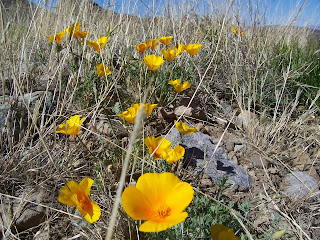
 |
| Three Little Hills |
 |
| Gym Peak in the distance. |
This was our most recent hike in the Floridas. My original plan was access the mines along the high ridge between Gym Peak and Baldy Peak, or climb Baldy Peak itself. I pulled a few waypoints off my AllTopo software and hoped for the best. My starting point for the hike was right at the Three Little Hills. This area is reached with the same road used to reach the Windmill Canyon hike. The road is not of the best quality past Windmill Canyon. It's very narrow, sandy and uneven, and requires a high clearance vehicle and most likely 4-wheel drive if it's wet.It probably took 40 minutes to drive the 10 miles from Rockhound State Park.
We walked down the old ranch road through a corral, until it unceremoniously ended near the intersection of 2 arroyos. We chose the one on the right and started steeply up without even a deer or cow trail, for the first ridge. Near the top we saw 5 or 6 mule deer moving along. We watched them as they watched us. Our Scottie, Seamus, would have much rather been chasing than watching. We then followed the deer path first to the high point of the ridge, where we found a favorite defecating spot of the local mountain lion (makes sense), and then to the other side, where we descended to a wide grassy saddle.




After that it was up through the abundant piñons and junipers on a north facing hillside.We found a small flat clearing among the trees to eat our lunch. It was sunny and pleasant and the wind had not become a factor yet. Still, when we saw the steepness of the climb we needed to make to reach our next waypoint, coupled with the prospect of being blown off the mountain the higher we went, we turned around. We chose to return via an alternate canyon rather than our original route- a mistake in hindsight- as it was brushy, thorny rocky and narrow, with one drop-off that had to be negotiated around on a gravelly slope that was more conducive to sliding than walking, in short, everything you'd expect from a typical desert defile.Looking at the topo map at home, instead of the BLM map that I had, there were two nice north facing canyons that would have made much better choices for our loop. We did come across an old tail-blade from a windmill, that could only have arrived there from being blown in from who knows where. We made it back in one piece.
Most places I go, it seems that a road or an old trail or even a good deer or cow path shows up to help me along in those place where the maps show no roads or trails. Don't count on it in the Floridas. The core of this range is a small, but true wilderness. Note: I haven't been there but it appears that the high ridge of the southern Floridas, anchored by massive Gym and South Peaks, is accessible by jeep roads and trails from the Mahoney Park area.
Labels: hiking

 These are two interesting sites north of Las Cruces. Across the highway from the tiny town of Rincon there is an old barite mine which may yield some interesting specimens if you search diligently. You may have to dig as well. It also seems to be serving as dumping area.If you follow the road that parallels Rincon Arroyo and eventually climbs a small peak, you may also find jasper and some strange ,small, petrified twigs in a creamy matrix.Several trails lead away from the large pit ( barite mine) to smaller prospects. One can be followed west to access an area with several dry waterfalls and small caves. It's here where petroglyphs are found, including several of the goggle-eyed Tlaloc. There are also grinding holes along the watercourse and one of the alcove/caves has a ceiling blackened by many fires. Exploring the nearby hills will reveal more sites that were most likely used as shelters by ancient peoples.
These are two interesting sites north of Las Cruces. Across the highway from the tiny town of Rincon there is an old barite mine which may yield some interesting specimens if you search diligently. You may have to dig as well. It also seems to be serving as dumping area.If you follow the road that parallels Rincon Arroyo and eventually climbs a small peak, you may also find jasper and some strange ,small, petrified twigs in a creamy matrix.Several trails lead away from the large pit ( barite mine) to smaller prospects. One can be followed west to access an area with several dry waterfalls and small caves. It's here where petroglyphs are found, including several of the goggle-eyed Tlaloc. There are also grinding holes along the watercourse and one of the alcove/caves has a ceiling blackened by many fires. Exploring the nearby hills will reveal more sites that were most likely used as shelters by ancient peoples.































































